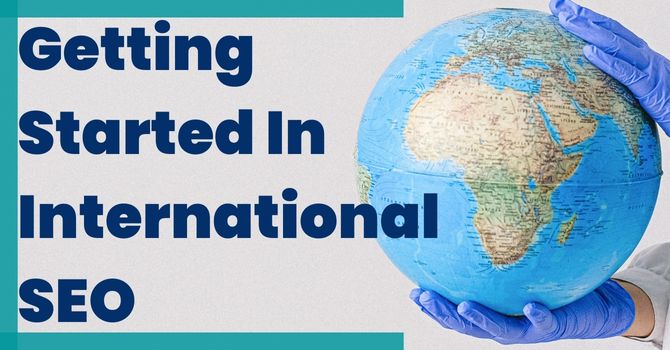Getting Started in International SEO
Having a global website is one of the best strategies for many businesses to reach a larger audience and expand their customer base.
As more quick and simple website design services become available, even a single person can launch a business by using a global website to reach other nations.
However, having a worldwide website does not guarantee success internationally.
Additionally, conforming to the accepted SEO best practices will not make your international website competitive in all target markets. While there seems to be an endless supply of material about global SEO, the majority of it is either incorrect or obsolete.
We’ll go through some of the most important aspects of global SEO in this article.
What Sets Local SEO Apart From getting started in International SEO?
The process of optimizing a company, good, or service for a local search query is known as local SEO.
When a user searches for a specific query, search engines like Google use the user’s location to determine which results they will display, such as IP address for desktop searches or geo-location for mobile searches.
This means that the search engine will display the nearby local companies when a user searches for a dentist, coffee shop, or car wash.
For instance, typing “dentist in Milan” or “dentist in Venice” will display dentists in that region if you’re searching for one when you’re in Italy.
The process of optimizing your website for visitors from other nations or languages is known as international SEO. It’s essential if you want to use organic search to reach a global audience.
But even for experienced SEOs, adopting international SEO best practices can be challenging.
So what distinguishes international SEO? The major determinants are:
- Languages.
- several websites
- well-known search engines.
- local audience
- competitors in the area.
When you have international websites, you must monitor each site individually as well as the overall performance. Otherwise, your local market websites might be in direct competition with one another or, worst-case scenario, might not even get indexed.
For instance, if you have a different website intended for Spain, your website for Mexico shouldn’t outrank or show up in the search results in Spain.
Some websites may not be indexed by search engines or may have duplicate indexing if the canonical tag or hreflang tag is misused.
The Importance of getting started in International SEO
Despite having its headquarters in the United States, Google is used all over the world and accounts for 92.96 percent of all traffic.
Additionally, millions of American businesses sell their goods and services abroad, and some of the biggest rely heavily on these sales for a significant portion of their revenue:
- Apple sales in international markets account for 60.7% of total sales.
- Ford accounts for 36.7% of sales worldwide.
- Google’s parent company Alphabet accounts for 53.8% of global sales.
- Walmart reports that 23.2% of its sales come from abroad.
That’s all wonderful for huge organizations with enormous finances, but what about tiny businesses, you might be thinking?
Here is the answer: When it comes to getting started in international SEO, SEO is a marketing tool that genuinely enables small businesses to compete with the big players.
International traffic is available for the taking, and user intent matching is one of the key components of SEO. In order to direct consumers to the page that best addresses their queries, search engines like Google and others often take location into consideration.
In the Bottle-O example, a person in Australia might type in Bottle-O to see the opening hours of their neighborhood Bottle-O. American searching for Bottle-O is likely doing so to learn what on earth one is.
Any material that fails to address the proper user intent will not have a chance of ranking because the two outcomes will be radically different.
In order to capitalize on the interest in your goods and services around the globe, international SEO best practices enable you to fulfill various customer requirements.
How to implement getting started International SEO
How should SEO implementation be done? You may create a global SEO plan to raise your profile internationally by following these steps.
1. Analyze your global SEO strategy
Since almost 70% of small businesses lack an SEO strategy, they are essentially operating without a plan.
You should always use SEO strategies that are supported by solid information.
It won’t be sufficient to simply have a “feeling” that you have potential in a particular nation. You must have concrete information.
Everyone has a marketing budget, and squandering it on pointless targeting can lower your ROI. Make sure your resources are concentrated in the nations with the most potential.
Fortunately, research will prepare you for each of the following processes, assisting you in selecting important goals, keywords, website structure, and more.
Although a lot more effort goes into effective international SEO, 71 percent of marketers list using strategic keywords as their top SEO tactic.
- Recognize your abilities
- Google Analytics or Ubersuggest are tools that can be used to estimate possible search volume.
- Examine user intent by manually searching Google and observing the results for the keywords you intend to target. Take note of any cultural variations, such as the usage of different phrases or phrasing.
- Identify obstacles to foreign sales and determine ways to overcome them.
- Give a solid justification for why investing in international SEO will benefit your business more in the long term than if you just concentrate on local SEO.
For this, project your realistic KPIs, such as income, customer acquisition costs, international search traffic, etc.
2. Select a URL Structure
The origin of the content you have developed is a key factor in getting started in international SEO ranking.
Would a German prefer to learn about bratwurst from a German website or one that has been translated into German from an American website?
There are four basic possibilities when it comes to where your website originates. Say your website’s domain name is www.bratwurst.com. Your choices would be as follows:
- a domain with a separate ccTLD, which functions something like an area code: www.bratwurst.de
- a subdomain of the website you already have: www.de.bratwurst.com
- your existing domain’s subdirectory: www.bratwurst.com/de
- Using a gTLD with language parameters, you can place language-specific content on your existing domain: www.bratwurst.com/?lang=de-de
Each choice has advantages and disadvantages.
The best indication that information is country-specific is a separate domain, but doing so necessitates maintaining a completely new website. On the other end of the spectrum, while choosing a gTLD with language restrictions may be the most practical option, the search engines receive a significantly weaker signal.
40 percent of domains end with .com, but if you make a transaction search in a country like the UK, you’re going to see that many of the results are dominated by .co.Uk websites (even though they might be owned by international companies).
We can observe a variety of URL formats in this example of a U.K. search for model train sets. These businesses vary in location, but they all have specific U.K. content.
Your choice will rely on your strategic planning and how much attention you want to devote to a certain country.
3. Make Your Site Language-Specific
In the world, more than 7,000 different languages are used. Even though you can’t reach everyone, you should make sure that your website is accessible in the language that your visitors prefer.
More crucially, Google will be judging your website according to this criterion because it wants to display results in users’ local languages.
Don’t only rely on machine translations if you’re serious about international SEO; they’re not yet accurate enough. Ensure that everything on your website (however you have chosen to set it up), from the navigation bar to the actual text, is written in the appropriate language.
Language tags are another tool you may use to direct Google. For instance, this “hreflang tag” notifies Google that a German-language alternative page is available, enabling them to rank the appropriate page.
Additionally, keep in mind that not all visitors prefer to browse in the language you anticipate. It can be incredibly annoying to automatically reroute users to content in multiple languages based on their location tag.
There are many occasions when viewers may desire to view your material in English while they are in another country or in America while they are in another country. Examples that come to mind immediately are individuals with work permits or executives on the go. Give them the option by giving them a button they can click rather than making the decision for them.
4. Customize Your Content
Users worldwide spend 54 seconds on each page they visit. You must produce content that corresponds to the intent behind their search queries if you want them to stay on your page.
We know, we know—we talk about user intent matching in SEO all the time. It’s because you’ll succeed if you produce content that corresponds to what visitors are seeking when they search for your target keywords.
Serving content in the appropriate language is only one aspect of user intent in international SEO. People search in many ways in order to find information that is pertinent to them. A term may be effective for you in English, but that doesn’t necessarily mean you can translate it into a foreign language and match user intent.
For a nation other than the United States, there are two techniques to ascertain user intent.
The first step is to utilize a VPN to search for important terms from a location inside the nation you’re aiming for. Using Ubersuggest is the second option. Simply type in a keyword and choose the target country in the country drop-down menu.
5. Do your internal linking correctly.
Internally linking to the wrong version is one of the simplest mistakes to make when distributing information worldwide. This may not only result in your users viewing the incorrect version, but it can also give Google confusing signals.
Hreflang implementation is required.
Hreflang is a piece of code that typically resides in a page’s backend (or sometimes via sitemaps). In essence, it’s a mapping procedure that gives Google a list of other URLs for a particular page.
This aids Google in comprehending:
- what audience the present page wants to appeal to.
- different choices for customers in other markets.
- a version that will be presented by default to visitors who conduct searches on markets without a specific page (optional).
- Hreflang implementation will improve user experience. It allows close duplicates to benefit your rankings (in particular, the versions that use the same language).
Key conclusions
- Use the URL format that best serves your needs (avoiding URL parameters at all costs)
- Localize your plan as much as you can, from content optimization to keyword research.
- To send Google unambiguous signals, use hreflang.
- Users care about site speed globally, so a CDN installation is essential.
- In all areas, keep improving the quality of your backlink profile.







